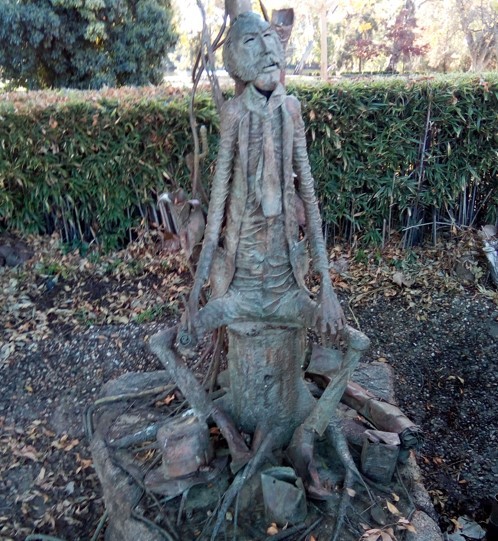This emaciated bronze sculpture, is in the Victory Memorial Garden of Wagga Wagga.

The Fictional Character of 'the Swagman'
A bronze plaque in front of the sculpture reads:
"THE JOLLY SWAGMAN"
This Sculpture was Unveiled by
Alderman B.N. Hedditch
Mayor of Wagga Wagga
on
24th August, 1978.
Aurel Ragus W.R. Ellis
Sculptor Town Clerk
While not much is known (researchable online) about Aurel Ragus, apart from possibly being born in Europe in 1923, there is much on the poem and song of "Waltzing Matilda", that 'The Jolly Swagman' is based one.
Wikipedia gives the "Waltzing Matilda" as 'Australia's best-known bush ballad, and has been described as the country's "unofficial national anthem"'.
"The title was Australian slang for travelling on foot (waltzing) with one's belongings in a "matilda" (swag) slung over one's back. The song narrates the story of an itinerant worker, or "swagman", making a drink of billy tea at a bush camp and capturing a stray jumbuck (sheep) to eat. When the jumbuck's owner, a squatter (landowner), and three mounted policemen pursue the swagman for theft, he declares "You'll never catch me alive!" and commits suicide by drowning himself in a nearby billabong (watering hole), after which his ghost haunts the site." [ex- Wikipedia: Waltzing Matilda]
The following is the 1903 version published by Cowan:
Waltzing Matilda
Once a jolly swagman camped by a billabong
Under the shade of a coolibah tree,
And he sang as he watched and waited till his "Billy" boiled,
"You'll come a-waltzing Matilda, with me."
Chorus:
Waltzing Matilda, waltzing Matilda,
You'll come a-waltzing Matilda, with me,
And he sang as he watched and waited till his "Billy" boiled,
"You'll come a-waltzing Matilda, with me."
Down came a jumbuck to drink at that billabong,
Up jumped the swagman and grabbed him with glee,
And he sang as he shoved that jumbuck in his tucker bag,
"You'll come a-waltzing Matilda, with me."
(Chorus)
Up rode the squatter, mounted on his thoroughbred.
Down came the troopers, one, two, and three.
"Whose is that jumbuck you've got in your tucker bag?
You'll come a-waltzing Matilda, with me."
(Chorus)
Up jumped the swagman and sprang into the billabong.
"You'll never catch me alive!" said he
And his ghost may be heard as you pass by that billabong:
"You'll come a-waltzing Matilda, with me."
(Chorus)
I had grown up with reading books by Australian author Ion Idriess (1889 - 1979), who himself worked as a sundowner in NSW until the First World War, when he enlisted in the 5th Light Horse Regiment. So I was familiar with the sundowners carrying their swag (rolled up bedding with whatever they owned) on a rope around their shoulder. These days a 'Swag' is quite an elaborate set-up, about three times the diameter of the rolled up blanket original, as it often has a 4 to 6 inch foam mattress that a true sundowner would have fainted at. [Details about Idriess from: Ion Idriess]
Wikipedia has a good article on the Swagman (link below), as follows:
"A swagman was a transient labourer who traveled by foot from farm to farm carrying his belongings in a swag. The term originated in Australia in the 19th century (and was later used in New Zealand).
"Swagmen were particularly common in Australia during times of economic uncertainty, such as the 1890s and the Great Depression of the 1930s. Many unemployed men travelled the rural areas of Australia on foot, their few meagre possessions rolled up and carried in their swag. Their swag was frequently referred to as "Matilda", hence Waltzing Matilda refers to walking with their swag. Typically, they would seek work in farms and towns they travelled through, and in many cases the farmers, if no permanent work was available, would provide food and shelter in return for some menial task.
"The figure of the "jolly swagman", represented most famously in Banjo Paterson's bush poem "Waltzing Matilda", became a folk hero in 19th-century Australia, and is still seen today as a symbol of anti-authoritarian values that Australians considered to be part of the national character." ex-Swagman
Visited: 1521, Friday, 1 June, 2018